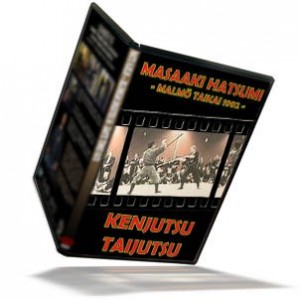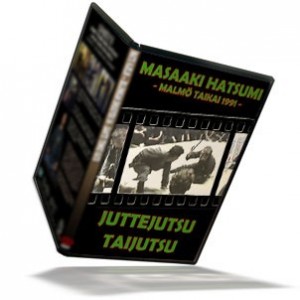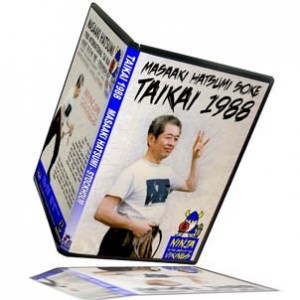Fun’Iki, Control The Environment
From Shiro Kuma's Blog by kumablog
 This year Mutō dori is about controlling Funiki, your environment.
This year Mutō dori is about controlling Funiki, your environment.
During the class, Hatsumi sensei demonstrated it with Taijutsu, Tantō, Katana, and Naginata. Each time the Uke seemed lost and unable to get him. His main point today was that the weapon, or the lack of it, is not what truly matter. In fact, with or without a weapon, Sensei was moving very slowly, keeping a perfect distance with the opponent, who always ended up cutting, stabbing himself, or getting controlled. There was no fight, no opposition, Sensei’s movements were natural. From the outside, it looked like Uke was fighting alone.
Sensei demonstrated it with the Tantō, using a unique grip that let his Taijutsu play by itself.
You hold the knife reverse, hiding it under your forearm and use either the blade or the Kashira to get Uke naturally. (2)
The key, he said, is not to use the Tantō, and to let Uke cut himself in the process. Correcting a student he told her that thinking about cutting with the blade, created a Teko (3), a point of leverage and focus that the opponent can use against you. Sensei added that in the case of a small weapon, it had to be always hidden.
But when Uke finally sees it, the trick is to let Uke “think” the knife while Tori still ignores it and his mind is not trapped by it. Sensei added that when you want to cut or stab with your knife, you are creating a fixed point in your mind limiting your freedom of action.
With the Naginata; it was even more devastating. Sensei said that when using this weapon, your grip of the weapon should be loose and all the movements executed using Naname. (4)
My understanding is that the physical encounter is enough to cut the enemy, your body supporting the Naginata loosely on top of the forearm. Also, keeping the edge oriented at 45 degrees guarantees a cut when in close-combat. The cuts are done by walking the body around Uke. When he was demonstrating this, I had the feeling the Naginata was alive and moving by itself.
In a sword against sword encounter, he explained to move towards the attack, using the body to support the blade as a shield. With the weapons in contact use the joints to apply leverage. Grab the opponent’s sword and then slide your katana under his helmet.
Finally, in Taijutsu, Sensei reminded us to use our fingers as if playing the piano on Uke. Then one finger extended was often enough to overcome the adversary even when he was armed with a sword.
All these techniques that we did were practical applications of high-level Mutō Dori. Mutō Dori is entirely misunderstood. It is not what we learned at beginner’s level. Mutō Dori is done in every situation, with or without weapons. Because it is about controlling Fun’iki (1), the environment, the atmosphere.
When your mental presence is aware of everything and controls the space between and around you and the opponent, then defeat is never yours. (5) (6)
The essence of Mutō Dori is Fun’Iki, to control the environment naturally.
________________________
1. 雰囲気, Fun’iki or Fuinki, air, atmosphere, environment
2. Kashira 頭, the head/top of the weapon/hilt
3. 梃子, lever(age). Teko – lever, and Shiten – fulcrum are one the secrets of the Kukishin Ryū
4. Naname 斜め, diagonal, oblique
5. Sensei used the word Fudōshin (不動心) to express it. And many of his attackers today explained that they cannot get him because of his commanding presence.
6. 不動心, Fudōshin: a) imperturbability; steadfastness
b) cool head in an emergency; keeping one’s calm (e.g. during a fight)







 …
…